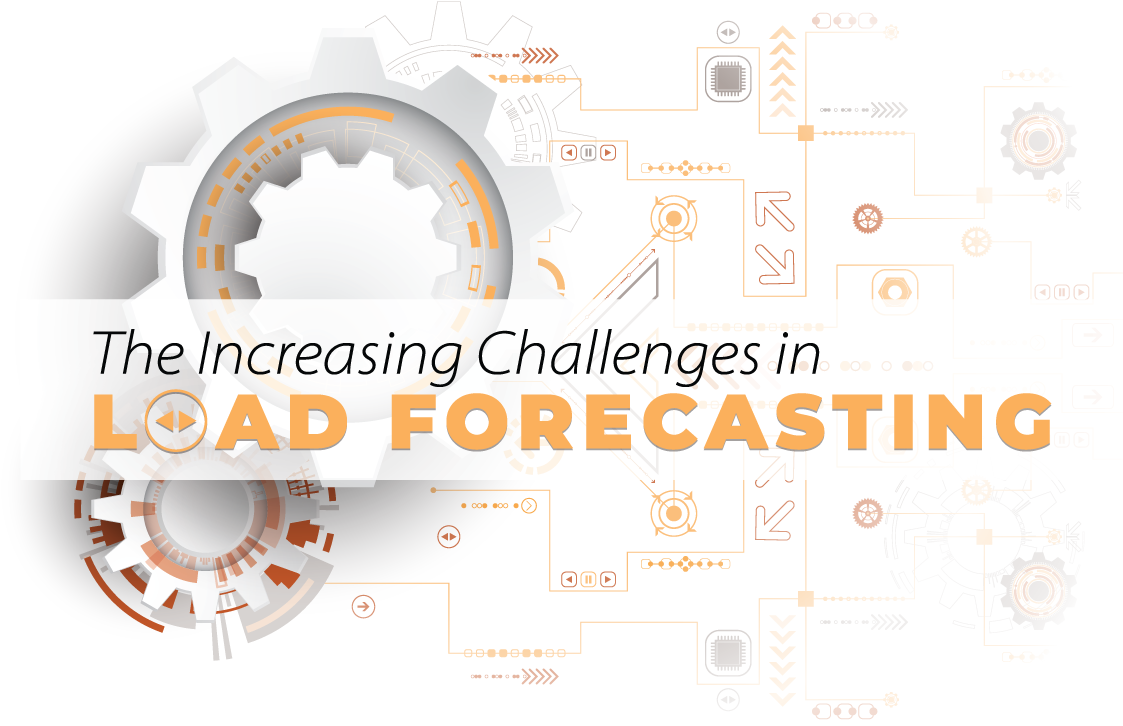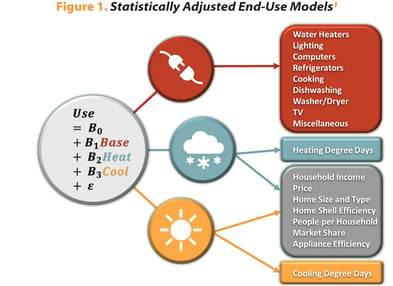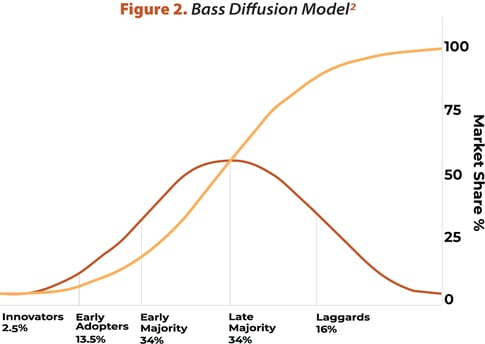- Home
- Services
- Hi-Line Engineering
- About
- Careers
- Contact
- Requests For Proposals
The Increasing Challenges in Load Forecasting
by GDS Associates, Inc | April 22, 2024 |
 The load forecast, or for the old hands among us, the power requirements study, is a useful planning tool, undergirding efforts such as budgeting, integrated resource planning, and energy efficiency/demand response market potential studies. As I like to say about a load forecast I’ve developed is that it’s guaranteed to be wrong or your money back! And of course, everyone realizes that planning in the future is difficult since the future of energy is fraught with uncertainty. And for load forecasters and planners, recent trends have increased the challenges of developing the best possible load forecast.
The load forecast, or for the old hands among us, the power requirements study, is a useful planning tool, undergirding efforts such as budgeting, integrated resource planning, and energy efficiency/demand response market potential studies. As I like to say about a load forecast I’ve developed is that it’s guaranteed to be wrong or your money back! And of course, everyone realizes that planning in the future is difficult since the future of energy is fraught with uncertainty. And for load forecasters and planners, recent trends have increased the challenges of developing the best possible load forecast.
Essentially from the time of rural electrification until about the mid-1990s, forecasting was a relatively uncomplicated process – load was directly tied to economic growth and therefore basic econometric models were usually sufficient for producing reasonable forecasts. Then as conservation and energy efficiency efforts increased, load and economic activity began to decouple, especially in the residential sector. We began to see economic growth but flat or downward trends in household consumption as homes became more efficient, even when utilities were not pursuing energy efficiency programs. So, energy forecasting evolved to capture these effects through a variety of approaches: end-use modeling, statistically adjusted end-use modeling [see Figure 1], and econometric approaches with greater focus on developing independent variables that captured the efficiency trends. And now within the last five-to-ten years, new developments in the industry are once again challenging load forecasters in ways that could have significant impacts on other planning studies. This article will touch briefly on three such trends, saving what might be the hardest challenge for last.
became more efficient, even when utilities were not pursuing energy efficiency programs. So, energy forecasting evolved to capture these effects through a variety of approaches: end-use modeling, statistically adjusted end-use modeling [see Figure 1], and econometric approaches with greater focus on developing independent variables that captured the efficiency trends. And now within the last five-to-ten years, new developments in the industry are once again challenging load forecasters in ways that could have significant impacts on other planning studies. This article will touch briefly on three such trends, saving what might be the hardest challenge for last.
BENEFCIAL ELECTRIFICATION
In the distant past, electric utilities encouraged additional energy sales, especially o -peak energy sales, through programs designed to encourage fuel switching. Such programs were called strategic load building or valley filling programs. Such programs became disfavored at the turn of the century as climate concerns generated negative political pressure on associations of encouraging increased electricity consumption for the sake of growth. In recent years, the concept has returned, with modification, in the guise of beneficial electrification, in which the concept is to replace direct fossil fuel use with electricity in a way that reduces overall emissions or environmental impact. Beneficial electrification includes electric vehicle adoption, which will be discussed in more detail later, but also replacement of other appliances that might represent reduction in greenhouse gas emissions, such as replacement of gas appliances with electric. In such fuel switching instances, forecasters for both electric and gas utilities must consider electrification effects.
Considerations for a forecaster include:
- Will the utility have a formal electrification program? If so, program impacts will likely be estimated during the planning and potential development stages of program design.
- How might natural electrification, driven by political and media attention, impact future market shares of electric end-use appliances. In such instances, an end-use or SAE modeling approach can help both electric and gas utilities understand how changing market share in appliances will impact future sales.
- Should impacts be modeled as part of base case forecast assumptions or built into scenario forecasts?
ELECTRIC VEHICLES
We’ve been trying to understand the impact that electric vehicles (EV) will have on forecasts and energy planning for some years now, so the sources a forecaster can rely on are more well-developed than the other issues forecasters are struggling with. However, EVs do still represent a challenge because for most utilities (some in California may be an exception), they are not well represented in the historical record that our forecast model rely upon. Therefore, forecasters are forced to perform post-modeling adjustments in which they independently project the specific impacts that EV will have on the system and then adjust the base case forecast.
With so many questions to answer, a forecaster might choose a simplified approach of trying to answer many of these questions with a simple assumption of “we’ll have 10% of vehicles within 20 years and a typical vehicle will require 400 kWh per month to charge”. Alternatively, a complex forecasting model that attempts to measure and answer all of the above questions can also be developed.
Critical questions for the forecaster to consider include:
- How many electric vehicles are currently on the system? State motor vehicle registration databases can give some indication.
- How fast will electric vehicles be adopted? There is a confounding number of sources a forecaster can draw upon for supporting information here, including quantitative (national adoption projections from various researchers and thinktanks) and qualitative (automaker manufacturers’ propagandized goals for electrifying their fleets). There are also decisions to make regarding adoption rates within the utility’s service territory. For instance, a rural cooperative with little interstate coverage in its territory might expected slower adoption than national rates. Finally, technical a consideration can be made as to whether to use linear growth assumptions or something more sophisticated like a Bass diffusion curve, which comes with an additional set of assumptions to make [see Figure 2].
- What is the average commute in miles and how many kWh of electric load are represented by the mileage?
- What is the mix of makes and models of electric vehicles, as they have different electrical draws during charging?
- How many cars do homeowners own on average in the service territory and how often are cars replaced?
- What is the share of charging at home on Level 1 and Level 2 chargers vs. away from home on DC Fast Chargers?
- When are cars being plugged in and are chargers being programmed to charge immediately or on a delayed/managed basis?
- What to do about non-residential electrification, such as school buses, delivery vehicle fleets, government fleets, and others?

NEW LARGE LOADS
For many utilities, forecasting large commercial and industrial loads is so difficult that the traditional approach has been to hold such loads constant into the future only making adjustments for expansions, contractions, and new loads based on highly likely known changes. Of course, “highly likely” is a very loose term. Furthermore, the forecaster must taking into account that the demand and load factor assumptions a developer or customer gives to the utility for new load is often overstated. The forecaster relies upon key account representatives and information gleaned from regular discussions that utility management often has with such loads.
However, that is beginning to change in ways that could have drastic implications on planning at the utility and regional level. Entering the conversation are very large loads with high load factors: data warehouses, cryptocurrency mining, artificial intelligence centers, and indoor agricultural facilities. The expansion for these loads is seemingly exploding right now, ranging in size from just a few MW to upwards of 1,000+ MW at one site! Developers are looking for the best deal for power and canvasing entire regions of the country looking for deals from different utilities. The challenge for a forecaster at any one utility is, how to include such opportunities in a load forecast? After all, one successful contract could double or triple a rural cooperative’s peak demand. Just because a developer has feelers out or even is negotiating basic contract terms means the full load will come to fruition. Utilities, especially Investor Owned Utilities with large service territories, are taking a harder look at including something for these loads in a load forecast.
Considerations for the forecaster include:
- What probability of likelihood should constitute inclusion in the forecast? Maybe enterprising forecasters will begin to assign probabilities and track their accuracy going forward. Or figure out a good use of Bayesian inference.
- What discount should be applied to estimate load impacts? Estimates by developers, customers, and even key account representatives are often overstated.
- Go with a stochastic approach, add unspecific “economic development” load, or only go with those that can be named and reasonably measured? A Monte Carlo simulation approach might allow for running various scenarios.
- Include such growth in the base case or in scenario or range forecasts?
- Should regional or market planners worry about multiple utilities counting on the same load potentials given developers tend to shop around?
CONCLUSION
The onset of beneficial electrification, including electrification of North America’s vehicle fleet, and potential very large loads associated with data warehousing and data mining are the new difficult cases for load forecasters. There are methods that are being developed, deployed, and refined over time, so the industry will continue to evolve. It is important to know, though, that these changes in how we use power have profound implications not just on forecasting, but on planning too. Distribution grid impacts could be significant from an influx of electric vehicles or aggressive electrification efforts. Similarly, gas systems should try to understand the impact electrification efforts will have on their utilities. And a single very large industrial load can represent significant system planning impacts, no doubt. Importantly, though, given the size of such projects and the lack of clarity concerning whether they will interconnect and when creates very real difficulties for long-term integrated resource planning. So we all should work with our forecasters to develop the best methods we can to predict electricity and gas needs into the future under scenarios driven by evolving trends.
 For more information or to comment on this article, please contact:
For more information or to comment on this article, please contact:Jacob Thomas, Principal
GDS Associates, Inc. - Marietta, GA
770-799-2377 or
jacob.thomas@gdsassociates.com
GET OUR NEWSLETTER
RECENT POSTS
- Exploring the 2026-2028 Reliability Standards Development Plan
- Blackstart Resource Availability During Extreme Cold Weather Conditions
- DOE Pushes FERC to Accelerate Large Load Grid Access
- Building a Cyber-Aware Workforce in the Utility Sector
- Cyber Resiliency in the Utility Sector: Lessons from the Field
Archives
- December 2015 (8)
- June 2025 (7)
- January 2016 (6)
- July 2016 (6)
- March 2021 (6)
- May 2022 (6)
- August 2020 (5)
- March 2015 (4)
- January 2019 (4)
- June 2019 (4)
- August 2019 (4)
- February 2020 (4)
- May 2020 (4)
- June 2020 (4)
- December 2020 (4)
- July 2021 (4)
- October 2021 (4)
- April 2024 (4)
- December 2024 (4)
- May 2025 (4)
- April 2015 (3)
- August 2016 (3)
- February 2017 (3)
- July 2017 (3)
- February 2018 (3)
- February 2019 (3)
- November 2019 (3)
- March 2020 (3)
- April 2020 (3)
- September 2021 (3)
- December 2021 (3)
- August 2022 (3)
- December 2022 (3)
- April 2023 (3)
- July 2023 (3)
- December 2023 (3)
- September 2024 (3)
- October 2025 (3)
- May 2014 (2)
- February 2016 (2)
- March 2016 (2)
- September 2016 (2)
- November 2016 (2)
- January 2017 (2)
- July 2018 (2)
- November 2018 (2)
- March 2019 (2)
- May 2019 (2)
- July 2020 (2)
- September 2020 (2)
- April 2021 (2)
- August 2021 (2)
- October 2024 (2)
- September 2025 (2)
- December 2025 (2)
- February 2014 (1)
- April 2014 (1)
- July 2014 (1)
- August 2014 (1)
- November 2014 (1)
- February 2015 (1)
- May 2015 (1)
- June 2015 (1)
- November 2015 (1)
- October 2016 (1)
- December 2016 (1)
- October 2018 (1)
- December 2018 (1)
- April 2019 (1)
- July 2019 (1)
- September 2019 (1)
- October 2020 (1)
- November 2020 (1)
- February 2021 (1)
- April 2022 (1)
- July 2022 (1)
- October 2022 (1)
- August 2023 (1)
- October 2023 (1)
- July 2025 (1)
- November 2025 (1)
Categories
- Newsletter - TransActions (85)
- News (78)
- Employee Spotlight (35)
- Energy Use & Efficiency (28)
- Energy, Reliability, and Security (16)
- Other Specialized Services (11)
- Environment & Safety (10)
- Power Supply (8)
- Transmission (8)
- NERC (7)
- Utility Rates (7)
- Cyber Security (5)
- Energy Supply (4)
- Hi-Line: Utility Distribution Services (4)
- Battery Energy Storage (3)
- Uncategorized (2)
- Agriculture (1)
- Hi-Line: Seminars & Testing (1)